How to Create an Automated Sales Funnel on LinkedIn
by Anna Sonnenberg /
Do you want to generate more sales from LinkedIn without actively prospecting? Curious how to build an automated lead generation process on the platform?
In this article, you'll discover how to turn your LinkedIn company page into an automated sales funnel in seven steps.
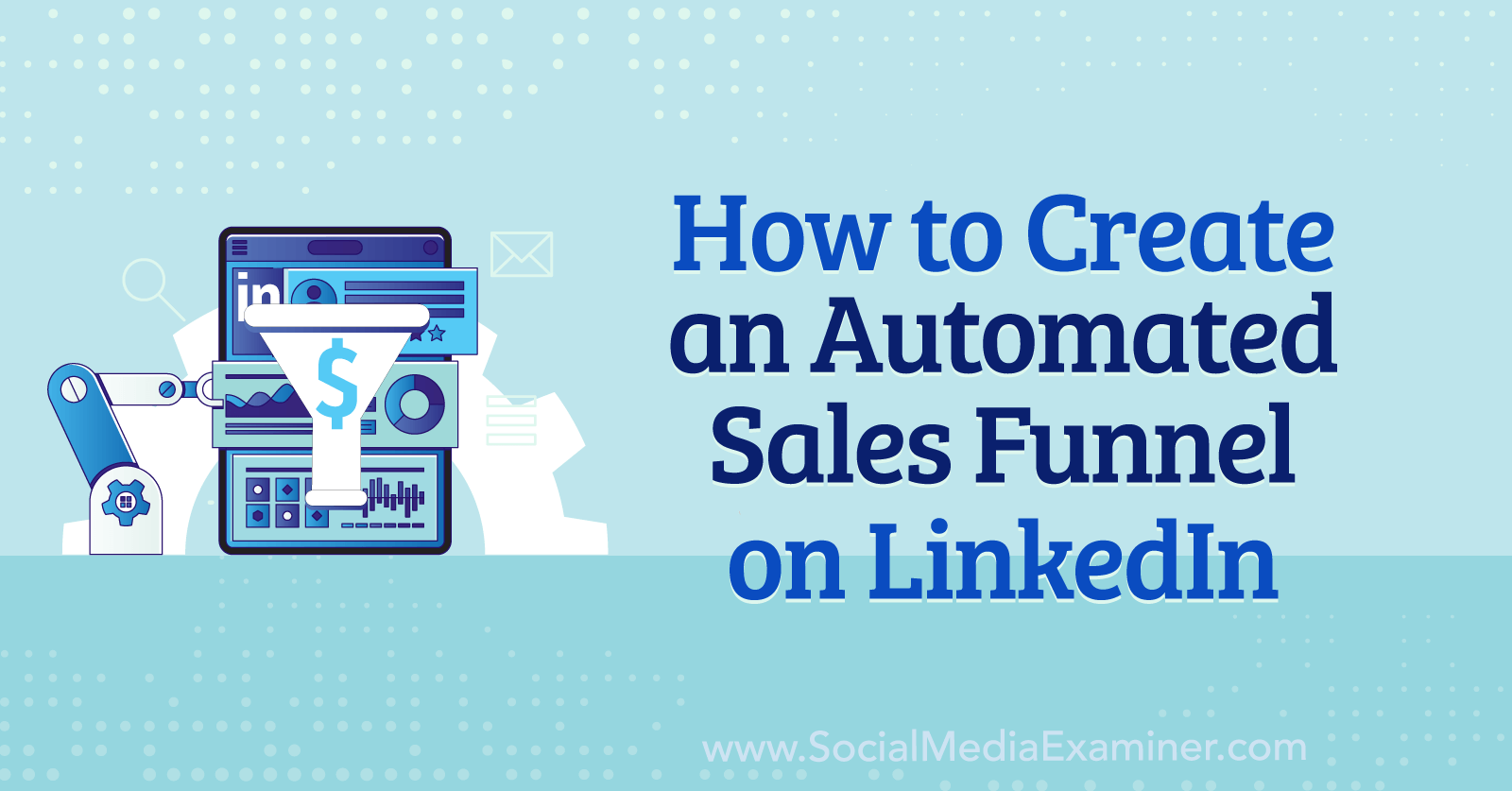
#1: Set Up Funnel-Based Conversion Tracking on LinkedIn
LinkedIn ads offer valuable opportunities to expand your reach, use native lead forms, and guide people through your funnel. But before you can create conversion-focused campaigns, you have to tell LinkedIn which events you want to target and track.
To access conversion tracking, go to LinkedIn Campaign Manager, open your account, and view your account assets. Then create new conversions for each step of your sales funnel. For example, you may want to track leads, signups, new trials, or subscriptions. You can also use this framework to track ad clicks and phone calls.
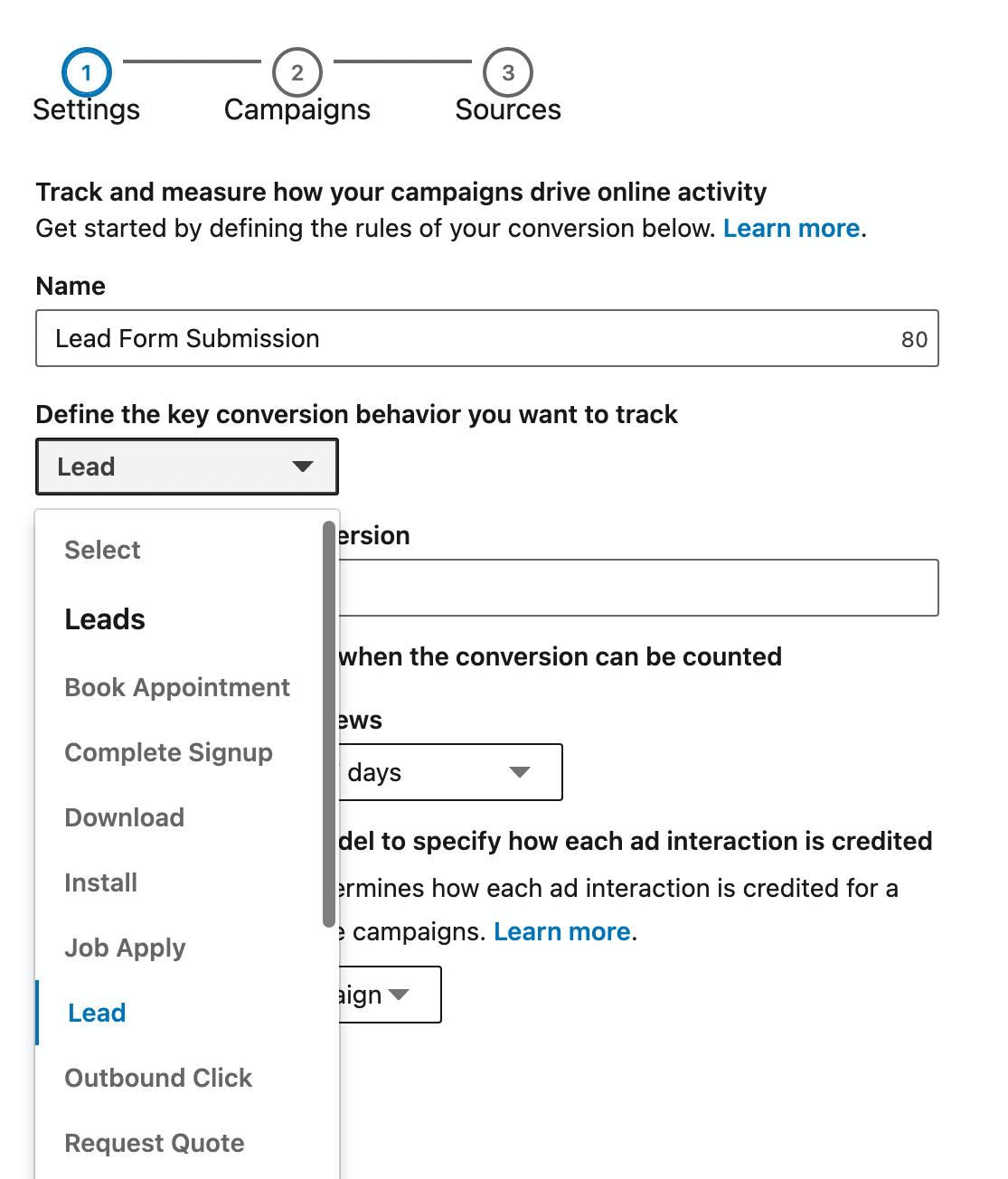
#2: How to Develop Top-of-Funnel LinkedIn Content
At the top of the funnel (TOFU), focus on organic posts that tell people about your business and introduce prospects to your products and services. Rather than providing tons of detail, create short-form content that entertains, educates, and engages.
For example, the Built In LinkedIn post below features a 30-second video that introduces people to the tech platform. The video features several types of tech professionals, making it easy for people to envision themselves as part of the community. The post also uses a branded hashtag for added visibility.
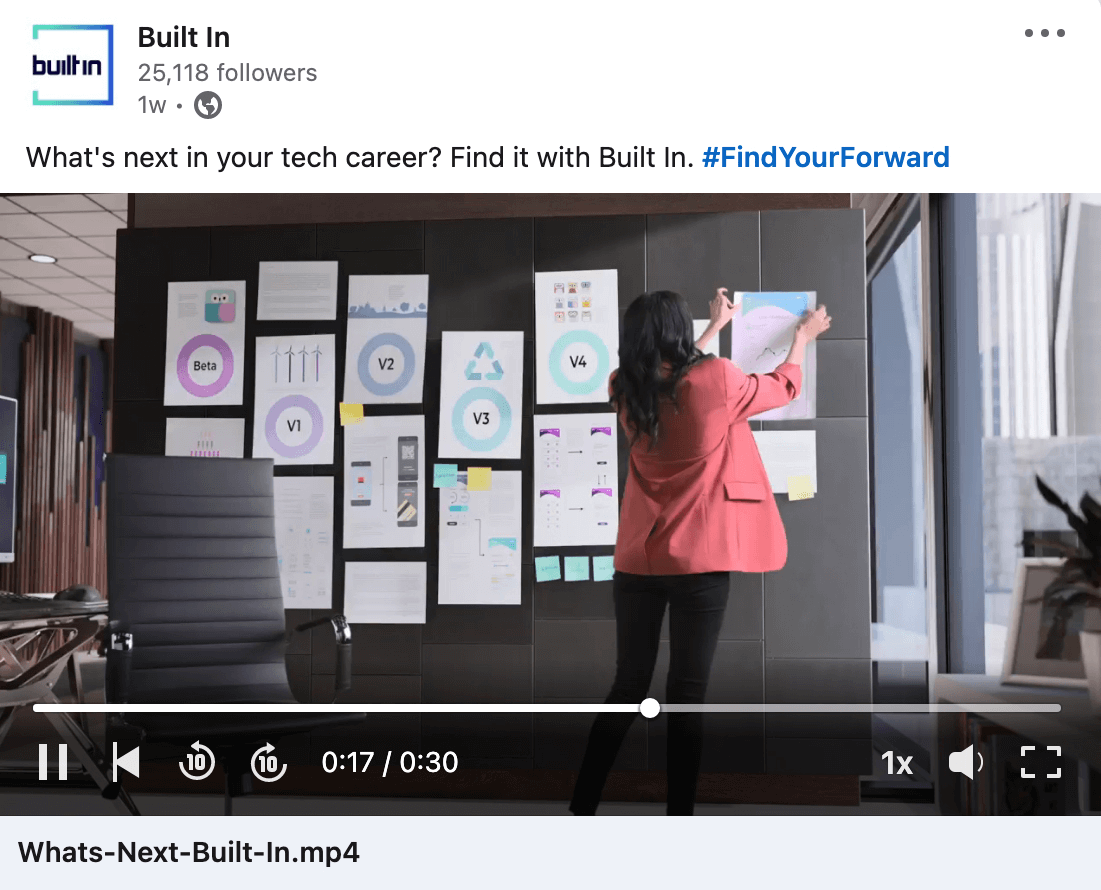
This stage of the funnel is also ideal for teasing upcoming product launches or driving awareness of new features. Whether you produce a video or write a text post on LinkedIn, aim to provide a basic overview rather than an in-depth guide to products and features.
For example, the Zoom LinkedIn post below includes an animated video that introduces the company's new contact center solution. Both the text and the video provide a surface-level overview but interested prospects can click the link to read a detailed blog post and learn how to implement the feature.
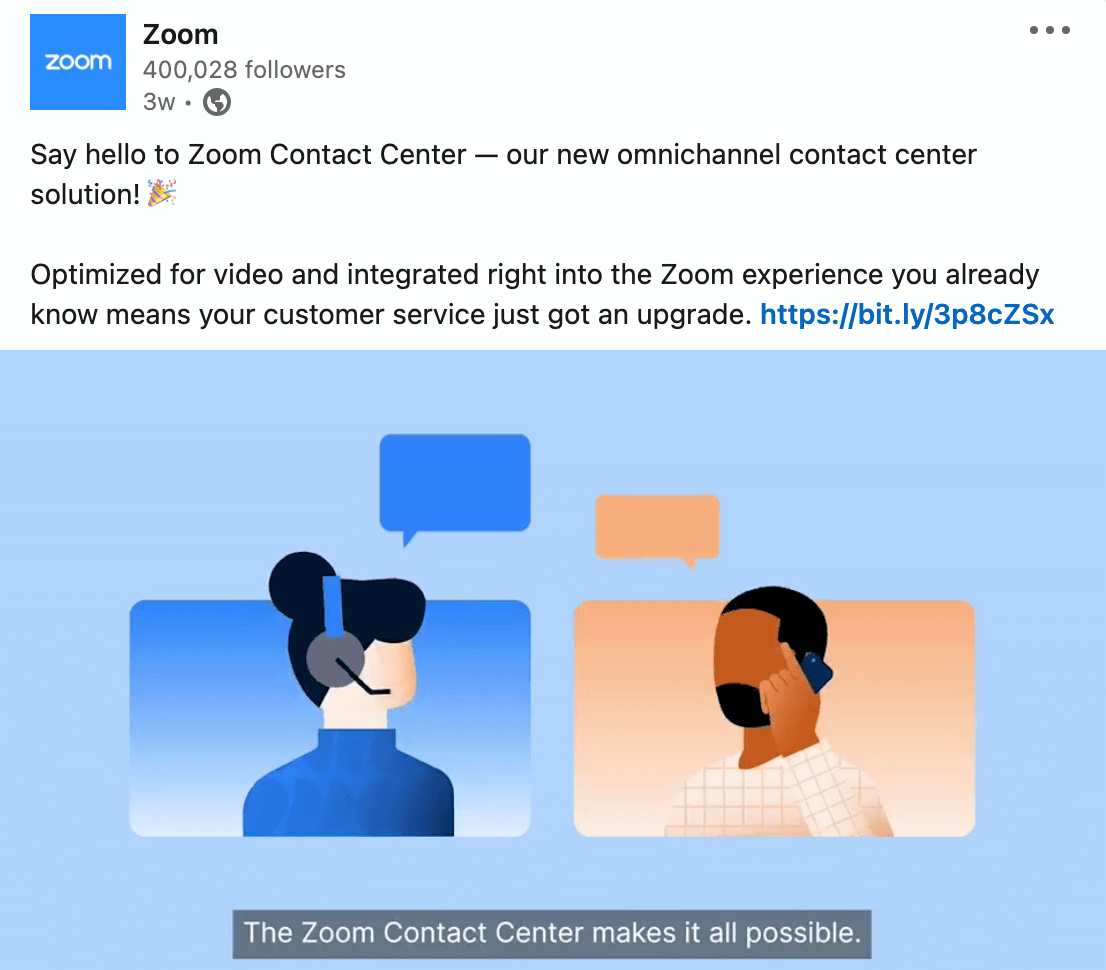
So how can you automate this part of the process? If you create TOFU content in batches, you can schedule it to publish automatically using any of the third-party social media tools that integrate with LinkedIn.
Check your LinkedIn company page analytics to find the optimal times to post and then schedule TOFU content in prime slots. Aim to alternate awareness-focused content with posts designed for other stages of the sales funnel so you can nurture prospects every step of the way.
#3: Boost Top-Performing Organic TOFU LinkedIn Posts
Your organic TOFU content may reach hundreds or thousands of people if your company page has a sizable following or if you share posts to your personal feed. But if you're serious about building a sales funnel, it's a good idea to boost your top-performing TOFU posts. That way, you can reach more of your target audience and keep adding new prospects to your funnel.
Use your company page analytics to identify top-performing posts. Then find the post you want to promote in your company page feed and click the Boost button to get started. For the objective, choose Increase Awareness to maximize impressions or Get Engagement to drive more reactions and comments.
Then select your target audience. You can reuse existing saved audiences or set new targeting parameters based on people's professional profiles or group memberships. Note that if you want to build a completely new audience using first- or third-party data, you have to go through LinkedIn Campaign Manager rather than boosting content from your company page.
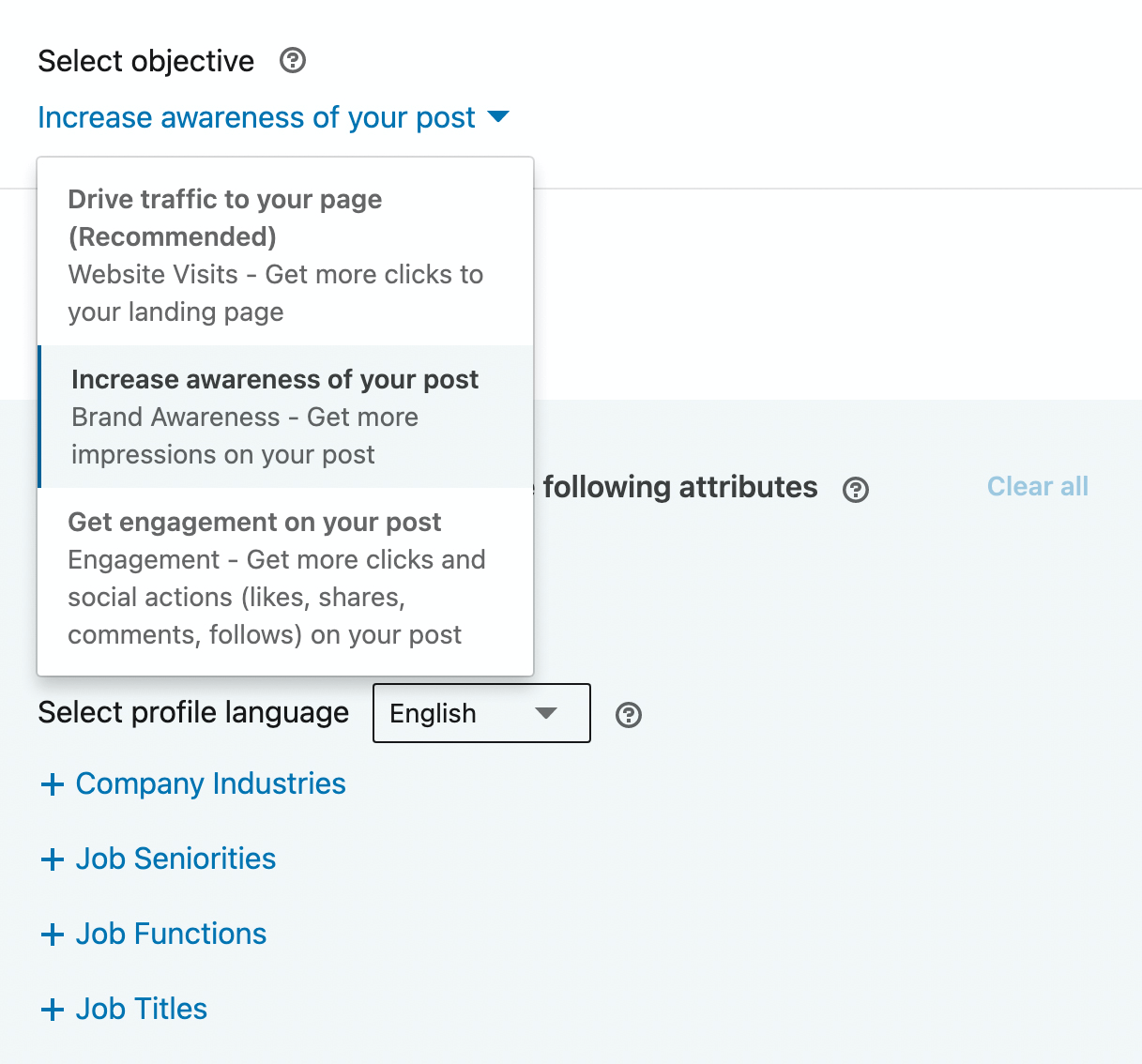
#4: How to Create Middle-of-Funnel LinkedIn Content
Now let's look at creating content for the middle of the funnel (MOFU).
Discover 125+ In-Depth Workshops—All in One Place

Curious about TikTok? ✅ Want to boost organic Facebook growth? ✅
In the Social Media Marketing Society, you get access to 125+ deep-dive training workshops from the industry's leading experts—live and on-demand. Explore training on trending topics for all major platforms, plus sessions covering email marketing, design, and video creation. It truly is your one-stop-shop for marketing greatness.
JOIN THE SOCIETY TODAY - DOORS CLOSE FRIDAYProspects who have moved past the getting-to-know-you stage understand what your business does and have a general idea of how your products and services can help. But they don't know all of the details and they aren't convinced that your offer is the best possible choice. That's why they're actively seeking out solutions and researching options.
Your MOFU content can provide the information prospects need to make an informed decision. At this stage, focus on creating more in-depth content. You can detail how your products can help, demonstrate how your services have worked for other clients, or share competitive research that shows your business is a top choice.
Although text posts can be incredibly informative, multimedia MOFU content creates opportunities for deeper engagement. Posts that encourage prospects to swipe through a carousel, watch a video, answer a LinkedIn poll, or click an external link are ideal for this stage of the sales funnel.
These formats drive interaction, which tells the LinkedIn algorithm to deliver your content more frequently. This type of content also helps you build activity-based audiences that you can retarget later, automatically guiding prospects further down the funnel.
For example, the Mutiny LinkedIn post below details how to make cold emails more successful. The post includes a carousel that people can swipe through to preview the steps. To get the full workflow, people can click the link in the comments, which leads to an in-depth blog post.
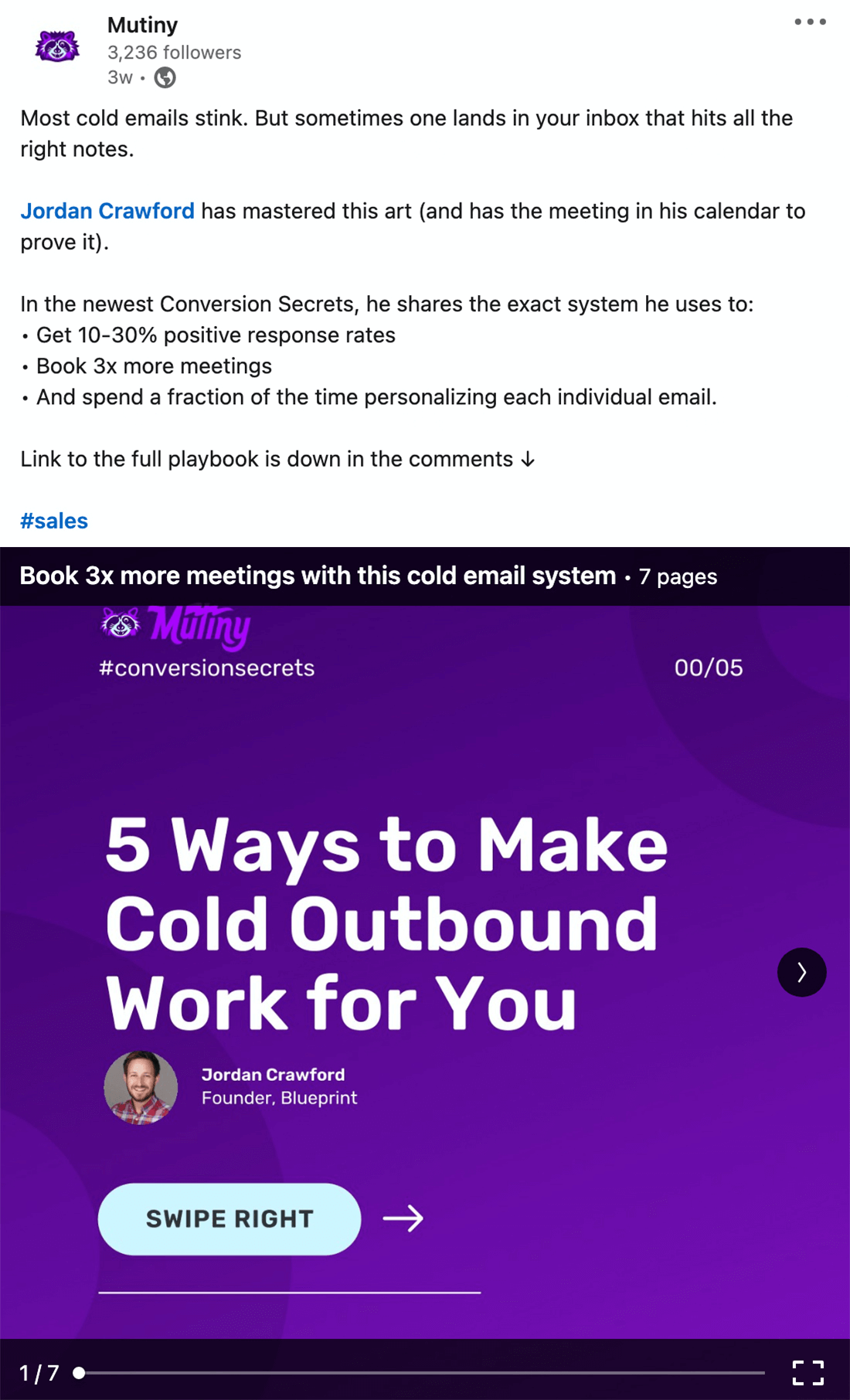
The Semrush post below uses LinkedIn's Documents feature to walk people through performing an SEO audit. The carousel provides a step-by-step solution to a common problem and also demonstrates how Semrush can become an integral part of an SEO toolset. For more details, prospects can follow the call to action (CTA) and click the link to read the full post.
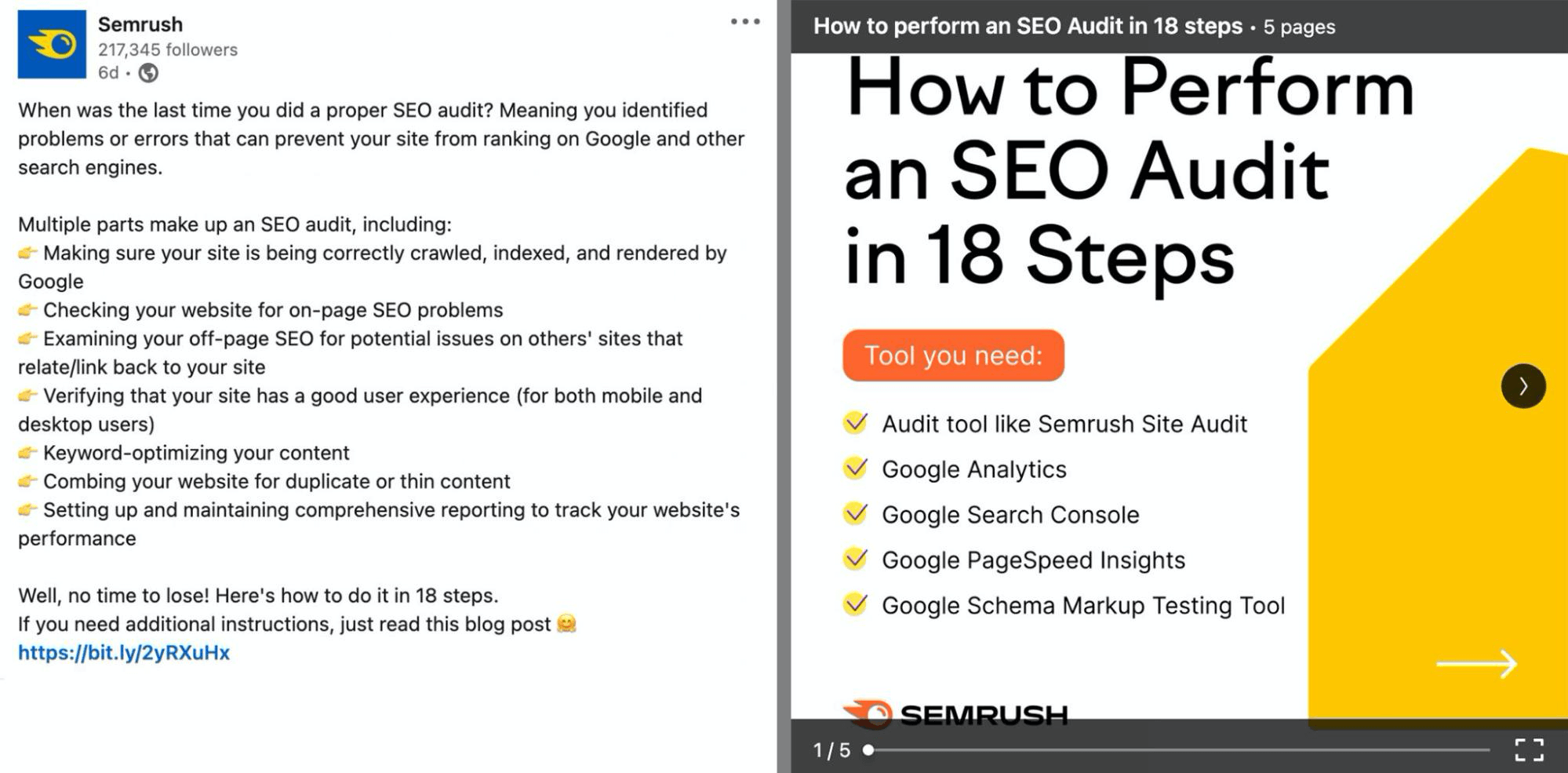
For prospects who are seriously considering solutions, case studies and customer spotlights can be particularly effective. With this type of content, you can share real-life outcomes your clients have achieved so prospects can better understand what you can help them accomplish.
Is Web 3.0 on Your Radar?
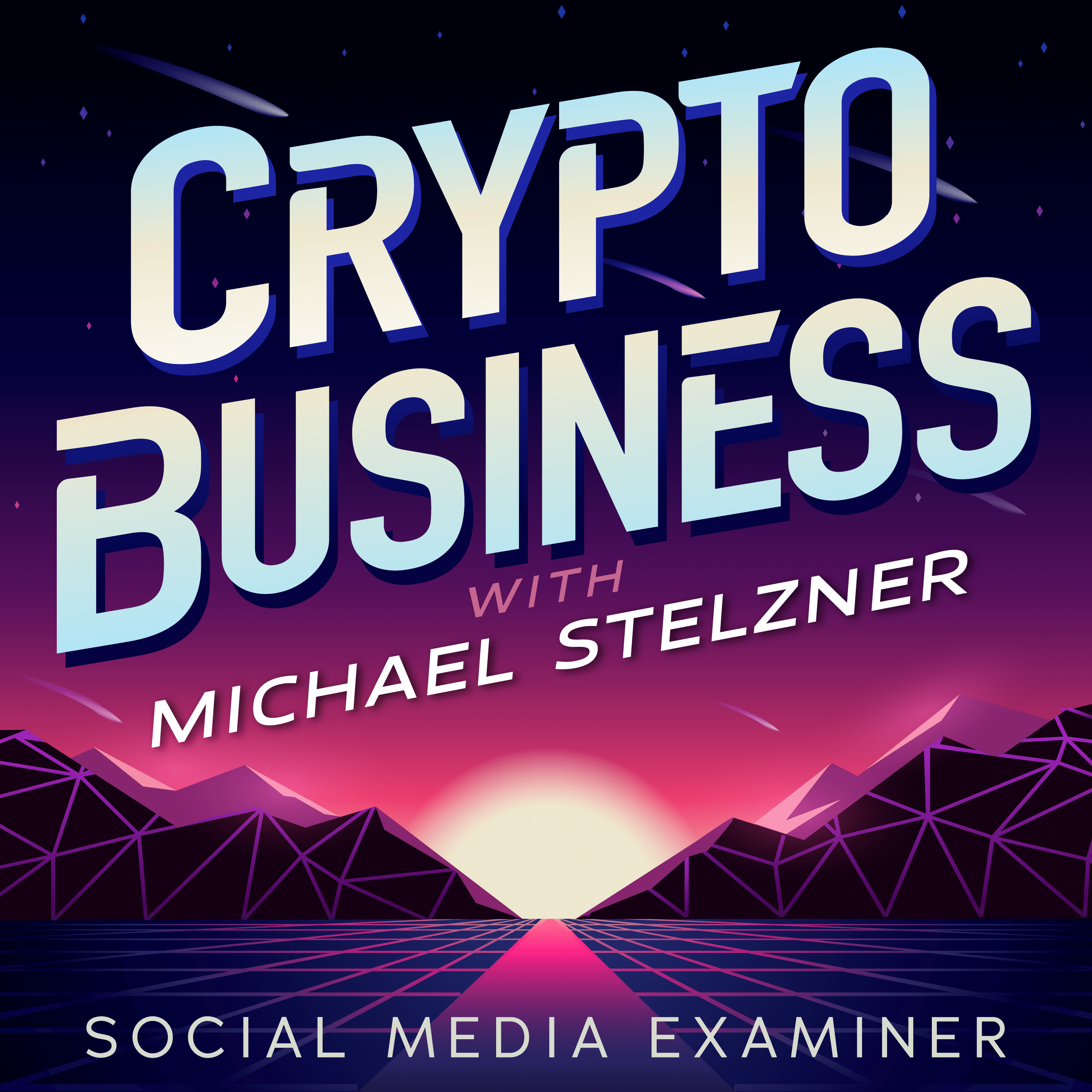
If not, it should be. This IS the new frontier for marketing AND business.
Tune into the Crypto Business podcast with Michael Stelzner to discover how to use Web 3.0 to grow your business in ways you never thought possible—without the confusing jargon. You'll learn about using NFTs, social tokens, decentralized autonomous organizations (DAOs), and more.
FOLLOW THE SHOWFor example, the Slack LinkedIn post below features a client spotlight. The linked blog post details how major brands have used the messaging app to deliver a better customer experience, illustrating how companies with similar needs could streamline workflows and improve outcomes with Slack.
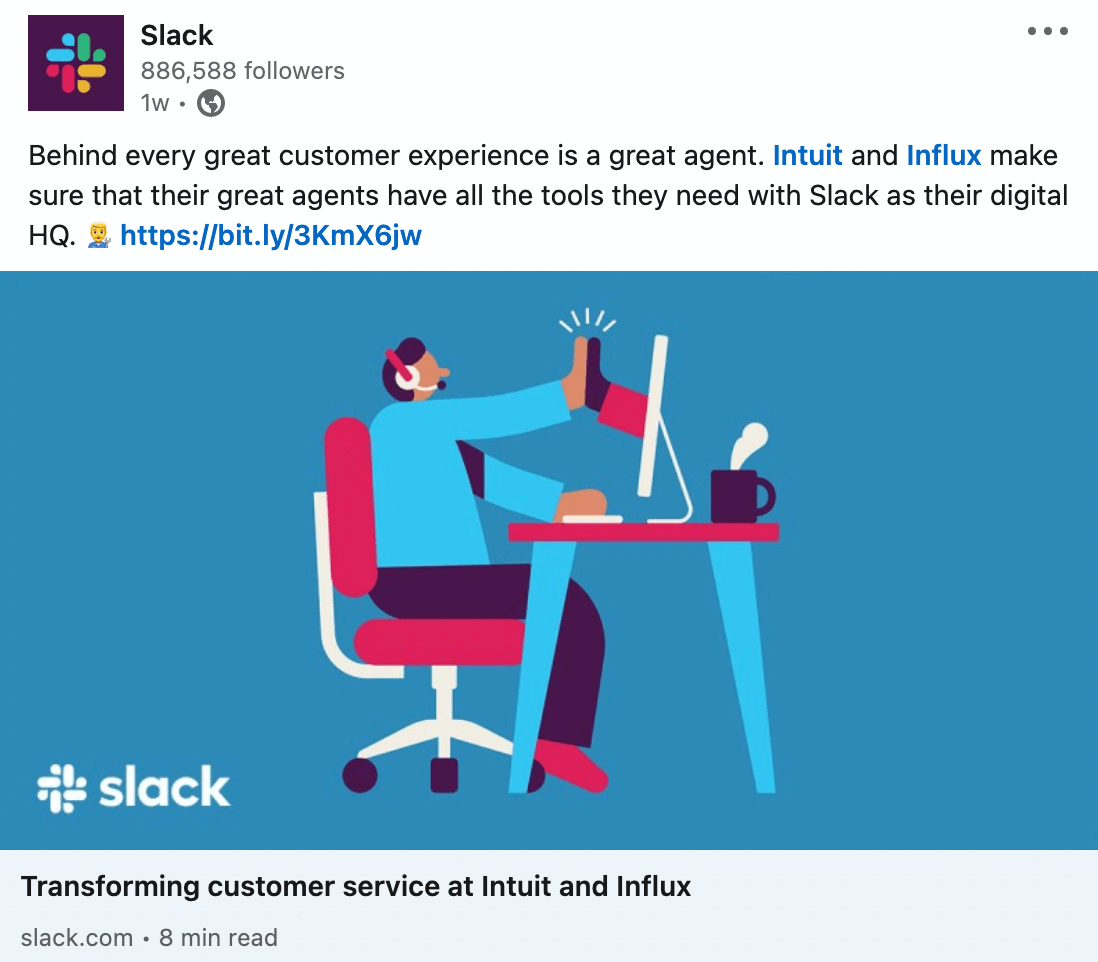
#5: Automate MOFU Retargeting With Paid Content
Most prospects need to see your content multiple times before making a decision or proceeding with a purchase. Although the exact number can vary by industry or product, eight marketing touchpoints is typical. These touchpoints can include your organic LinkedIn content and your blog posts—and they can also include ads.
To accelerate these touchpoints and move prospects through this stage of the funnel more efficiently, use Campaign Manager to run consideration-focused campaigns. If you use retargeting audiences, you can guide prospects through a customized series of touchpoints designed to address their specific needs. Here's a sample workflow:
- Publish an organic carousel post that links to a blog post introducing people to a topic.
- Create a LinkedIn video ad that takes a deeper dive into the topic and retargets people who visited that blog post.
- Publish a website traffic ad that links people to a detailed how-to guide and retargets people who watched your LinkedIn video ad.
- Design another video ad that shares a client spotlight and retargets people who visited your how-to guide.
- Run a website traffic ad that links people to an in-depth case study on the topic and retargets people who viewed your client spotlight video ad.
Depending on the value of your offer and the awareness level of your audience, you can add or remove touchpoints from this advertising funnel. Keep in mind you'll add the final touchpoints in the conversion stage of the funnel. No matter how many touchpoints you include in total, using retargeting audiences is an effective way to guide engaged prospects through your funnel and toward a conversion.
To create retargeting audiences on LinkedIn, open your ad account in Campaign Manager and navigate to your Matched Audiences. Click the Create Audience button to retarget based on a video ad, a single image ad, website data, or even company page activity. Then set the parameters for the audience such as the specific ad or web page audience you want to retarget.
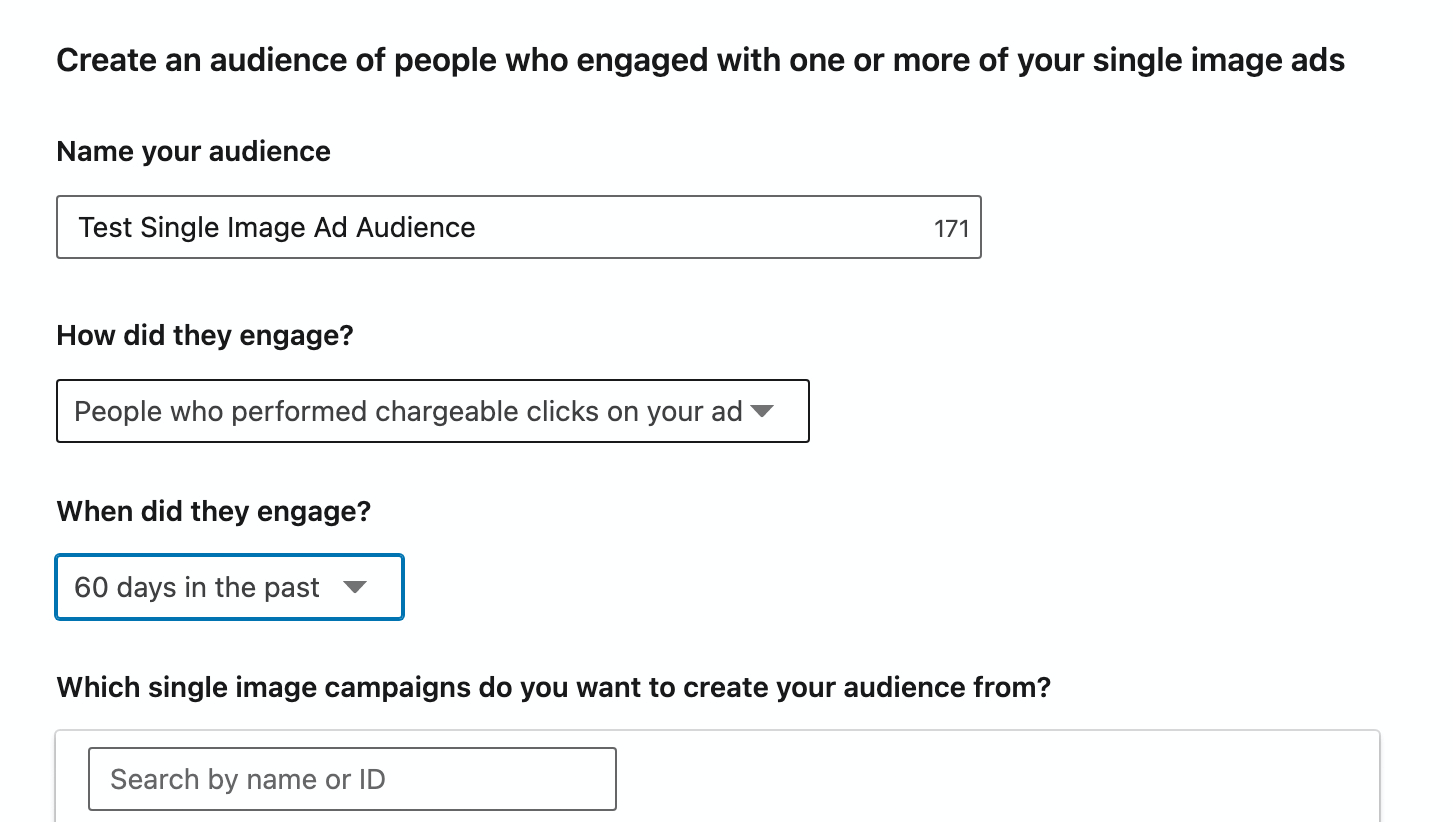
#6: How to Design Bottom-of-Funnel LinkedIn Content
Finally, let's look at content that encourages engaged prospects to convert.
At the bottom of the funnel (BOFU), remaining prospects have a strong interest in your solution. But something's preventing them from taking the final step. Perhaps they have lingering questions. Maybe they're researching competitors. Or they may be waiting for the right offer. If you can provide the final piece of the puzzle, there's a good chance you can secure a sale.
Sharing high-value content at no cost can be particularly effective for converting BOFU prospects. It gives them a better idea of what your product or service is worth, which can instill trust in your business.
Here are a few ideas for organic BOFU content:
- LinkedIn Live events, which let you connect with prospects in real time. You can also follow up with attendees afterward to provide additional resources or make offers.
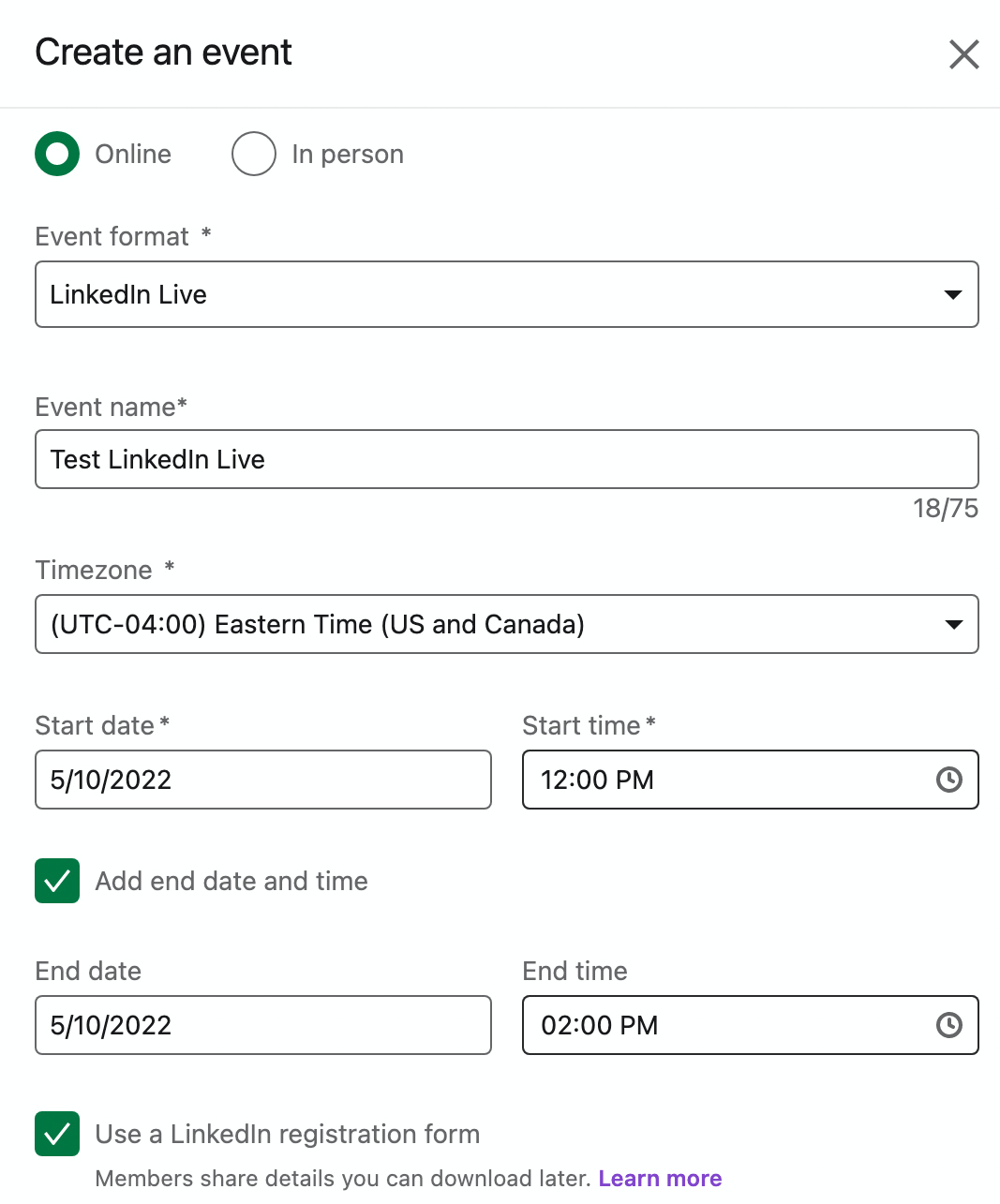
- Gated content, which lets prospects download valuable guides and reports in exchange for their contact details. You can nurture these leads via email and add them to your retargeting audiences.
- Free trials and product demos, which get prospects in the door and onboard them into your system. You can automatically follow up with these leads, encouraging them to upgrade or subscribe to a paid plan.
#7: Retarget Serious Prospects Automatically
To lead prospects through the final stage of the sales funnel, use the lead generation and website conversions objectives for LinkedIn retargeting campaigns. With the lead generation objective, you can encourage prospects to fill out a native lead form to request a personal follow-up or to access a high-value lead magnet.
For example, the Affirm LinkedIn ad below makes a strong case for the financial tech company's pay-over-time solution. Prospects can click the Learn More button to fill out the native lead form and request more information. The company can use the provided details to qualify leads and nurture them accordingly.
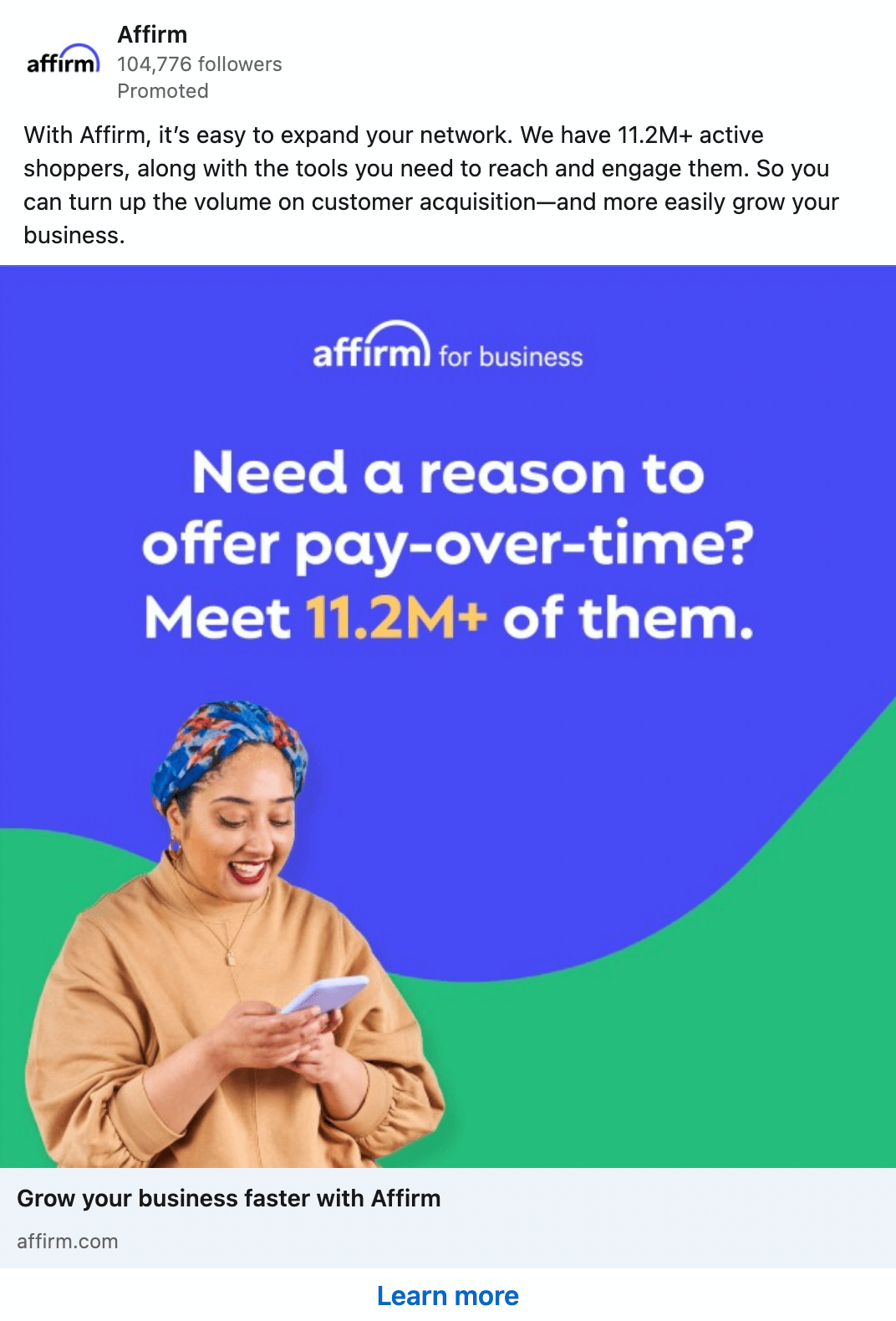
With the website conversions objective, you can encourage prospects to complete specific actions on your site. You can invite them to attend an event, download a lead magnet, or request a product demo—all of which require them to provide contact details for future follow-ups.
For example, the Event Farm LinkedIn ad below highlights a webinar designed for event planners. Prospects can click the CTA button to visit the event engagement tool provider's website, register for the webinar, and opt into additional marketing and sales emails.
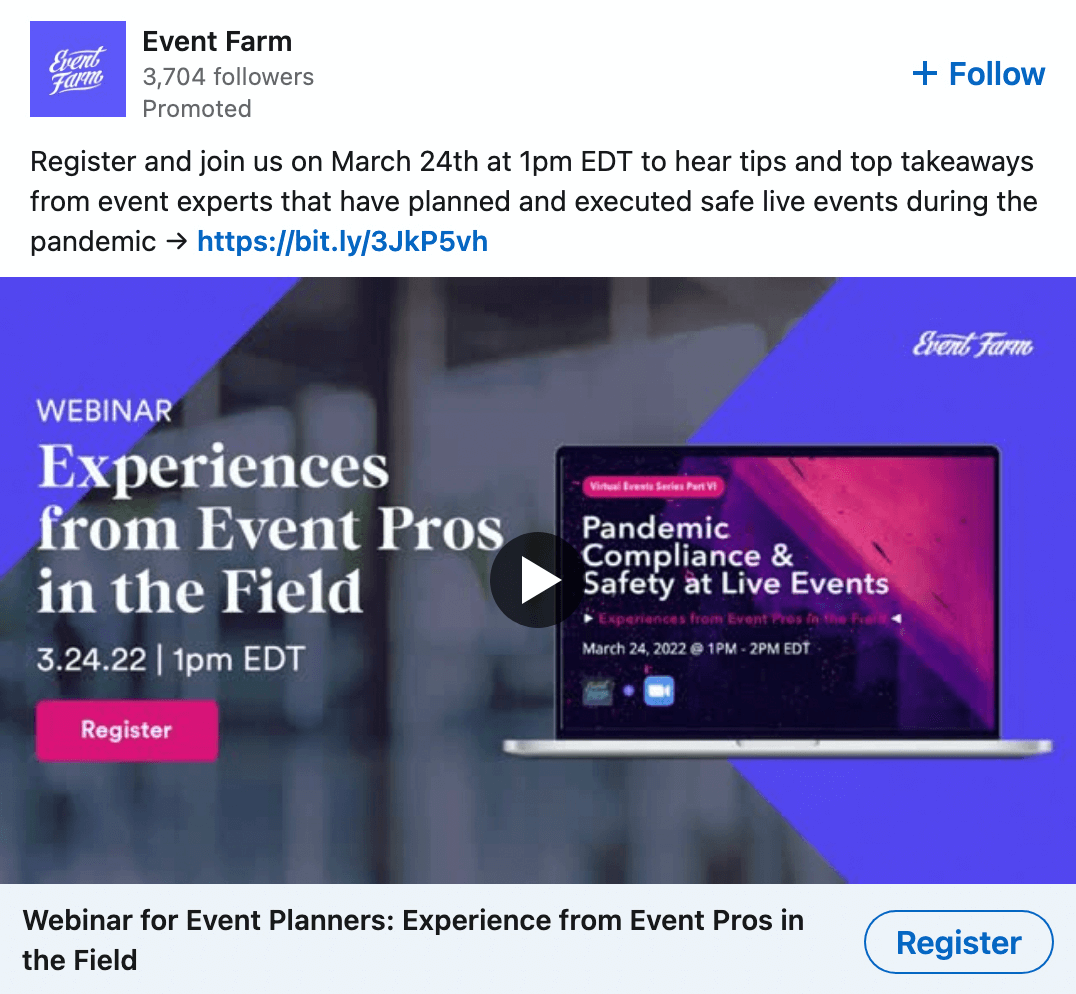
Here's a sample workflow for conversion-focused ads:
- Run a lead generation ad that offers a lead magnet and retargets people who read the case study you promoted during the consideration stage.
- Use the contact details your prospects provided to email them directly. Add your customer list to LinkedIn and create a new retargeting audience.
- Create a website conversions ad that highlights a free trial and retargets people from your list of qualified leads.
Conclusion
Before you build a funnel, take a few minutes to optimize your LinkedIn presence for lead generation and conversions.
Prospects may discover your business on LinkedIn in several different ways: through a search, by seeing your ads, or via an organic content share. When they visit your company page, however, you want them to find all of the information they need to trust your business.
Make sure you've taken all of these steps to complete your company page:
- Upload a cover image and consider updating it regularly. This prime spot is the ideal place to highlight awards or showcase offers.
- Add a CTA button that links to your site. Test out the various CTA buttons that LinkedIn offers to see what drives the most traffic.
- Optimize the tagline and About section. Add relevant keywords to tell prospects what you offer and increase the chance of appearing in relevant searches.
- Showcase your specialties. Choose up to 20 specialties to guide the LinkedIn algorithm and increase the chance of appearing in search.
Using a combination of paid and organic content, you can create a successful sales funnel on LinkedIn. By retargeting the right people, you can guide interested prospects through your funnel automatically so you can secure sales and meet your goals more efficiently.
Get More Advice on LinkedIn Marketing
Got Tough Marketing Questions? Get the Answers Here

Inside the Society, you get exclusive access to an always-on community of thousands of experienced marketers from all over the world. Including many of our trainers!
That means you can ask tough questions—and get real, actionable answers—on the fly. No more screaming into the void only to be rewarded with *crickets.*
JOIN THE SOCIETY TODAY - DOORS CLOSE FRIDAY


0 Comments